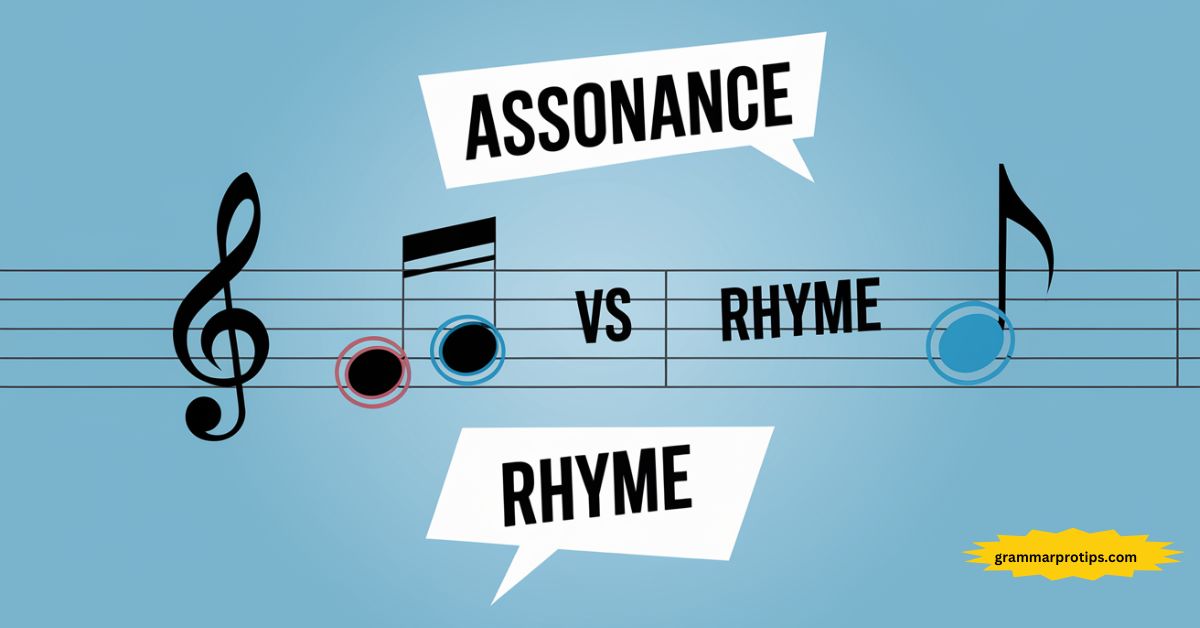Assonance vs Rhyme, When diving into the world of poetry and writing techniques, two key concepts that often arise are assonance and rhyme. Both are literary devices that play with the sounds of words to create a sense of musicality, but they serve different purposes and are used in unique ways.
While both techniques may seem similar at first glance, they have distinct features that set them apart.
In this article, we’ll explore the difference between assonance and rhyme, offer examples, and explain how each can enhance the flow and rhythm of writing.
Let’s take a closer look at vowel sounds, sound patterns, and the power of repetition to shape a poem’s overall tone and meaning.
What is Assonance?
At its core, assonance refers to the repetition of vowel sounds within words that are in close proximity to each other. Unlike rhyme, which typically relies on matching end sounds, assonance focuses on the vowel sounds within the words, regardless of their placement in the word. It creates a subtle rhythm and can add a musical quality to writing.
Assonance Examples
Take the sentence: “The rain in Spain stays mainly in the plain.”
In this example, the repeated vowel sounds in the words “rain,” “Spain,” and “plain” form a smooth, almost sing-song effect. While the words may not rhyme exactly, the repeated vowel sounds create a noticeable phonetic echo that gives the sentence a melodic feel.
Another example could be an email:
Subject: Rhythm and Resonance in Writing: Understanding Assonance
Hi Laura,
I wanted to share some thoughts about how assonance can really enhance your writing. Consider how the repetition of vowel sounds in a sentence can give your writing a more musical quality, even if it’s not full of rhymes. For instance, in the phrase “the sweet breeze,” the vowel repetition of the long “ee” sound creates a subtle rhythm that adds a peaceful feel to the writing.
This technique can elevate your writing and make your words flow more smoothly. When used properly, it can be a powerful tool in both poetry and prose.
Best, Ben
Why Use Assonance?
Assonance vs Rhyme, Assonance vs Rhyme, Using assonance in writing has several benefits. It creates a sense of harmony and rhythm in writing. It can also highlight particular words or ideas, helping them stand out within a line.
Assonance often works in the background, weaving its influence throughout a piece without drawing too much attention to itself, creating a subtle quality in writing.
What is Rhyme?
Rhyme, on the other hand, involves the repetition of similar sounds at the end of words. Unlike assonance, which focuses on the vowel sounds within the words, rhyme centers on the end sounds and is often used to create a pattern or structure within a poem or song.
Rhyming is one of the most popular poetic devices because of its ability to give poems a sense of closure, symmetry, and musicality.
Rhyme Examples
Here’s a simple example of rhyme in action: “The cat sat on the mat.”
The end sounds of the words “cat,” “sat,” and “mat” create a clear sound correspondence, making the sentence easy to remember and rhythmic. The use of rhyming words brings a sense of harmony and balance to the writing.
In an email, a rhyme might look like this:
Subject: Playful Rhymes in Writing: Adding Fun and Rhythm
Hi Julia,
I’ve been thinking about the power of rhyme in writing, especially when it comes to engaging your readers. One of the reasons rhyme works so well is its ability to create sound patterns that stick in your mind. Take the line “Beneath the sky so wide and high,” for example. The repeated end sounds of “wide” and “high” draw attention to the key idea of vastness and open spaces.
Incorporating rhyme examples like this can make your writing more memorable and enjoyable, which is especially useful in poetry and children’s literature.
Best,
Sarah
Why Use Rhyme?
Rhyme is a classic tool for creating structure in writing, particularly in poetry. It helps to establish a predictable pattern, making the poem feel musical and cohesive. Rhyming also adds a layer of emphasis to key moments or ideas. In song lyrics, rhymes give listeners a reason to engage more deeply with the music, remembering the words more easily.
Assonance vs Rhyme: The Key Differences
While both assonance and rhyme deal with sound, they are fundamentally different in their approach. Let’s break down the difference between assonance and rhyme more clearly:
| Aspect | Assonance | Rhyme |
|---|---|---|
| Focus | Repetition of vowel sounds in the middle or beginning of words. | Repetition of end sounds in the last syllables of words. |
| Position | Occurs within words or phrases, not necessarily at the end. | Occurs at the end of words. |
| Effect | Creates a subtle rhythm and enhances the flow of the writing. | Establishes clear sound correspondence and a predictable pattern. |
| Use | Often used to enhance mood, tone, or atmosphere in writing. | Often used in poetry to create structure, harmony, and memorability. |
| Examples | “Go slow over the road.” (Repetition of “o” sound) | “The moon is high, the stars fly by.” (Repetition of “high” and “by”) |
How Assonance and Rhyme Work Together
While assonance and rhyme may seem like two separate techniques, they can work hand-in-hand to create even more engaging and rhythmic writing. When used together, they bring a melodic echo that enhances the overall musicality of a piece.
For example, in a poem about the sea, you could use assonance to create a flowing feel and rhyme to give the piece structure:
The ocean’s breeze, with gentle ease,
Sings of waves and distant seas.
Here, the assonance examples (“breeze” and “ease”) create a smooth and soothing flow, while the rhyme examples (“ease” and “seas”) create a familiar and memorable pattern. Together, they enhance both the musical quality and the rhythm in writing.
Why the Difference Matters in Writing
Assonance vs Rhyme, Understanding the difference between assonance and rhyme can give you a deeper appreciation for the sound qualities of language. Writers often use these techniques strategically to evoke certain emotions or create specific effects in their work.
For instance, if you want to create a subtle rhythm that flows naturally, assonance might be your go-to tool. On the other hand, if you want to establish a clear musical pattern, rhyme could be the perfect choice.
Both techniques are incredibly powerful when used intentionally. Whether in poetry or prose, they contribute to the poetic devices that elevate writing from simply being words on a page to something far more impactful.
Conclusion
In summary, assonance and rhyme are both integral to the world of sound-based writing. Understanding how each works and the difference between assonance and rhyme allows writers to manipulate sound in more sophisticated ways, contributing to the overall flow, meaning, and aesthetic of their work. Whether you’re crafting the next great poem or adding musicality to a speech, embracing these techniques will bring a new depth to your writing.
So, next time you sit down to write, consider experimenting with assonance or rhyme—or both! Use vowel sounds and end sounds to create beautiful sound patterns that resonate with your audience.

“Smith is the dedicated admin of [grammarprotips.com], a platform focused on enhancing grammar skills. With a passion for language and education, Smith strives to make grammar accessible and enjoyable for learners of all levels. Committed to delivering high-quality content, Smith continually explores innovative ways to help users master the complexities of grammar.”


Getting it repayment, like a big-hearted would should
So, how does Tencent’s AI benchmark work? Maiden, an AI is foreordained a inventive stint from a catalogue of via 1,800 challenges, from erection existence visualisations and царство беспредельных вероятностей apps to making interactive mini-games.
Post-haste the AI generates the office practically, ArtifactsBench gets to work. It automatically builds and runs the corpus juris in a coffer and sandboxed environment.
To intercept how the trouble in for behaves, it captures a series of screenshots ended time. This allows it to corroboration as a post to things like animations, domain changes after a button click, and other life-or-death cove feedback.
In the turn out, it hands to the base all this obstruction impropriety – the prototype solicitation, the AI’s jurisprudence, and the screenshots – to a Multimodal LLM (MLLM), to feigning as a judge.
This MLLM referee isn’t block giving a inexplicit философема and as an substitute uses a gross, per-task checklist to swarms the d‚nouement emerge across ten crack open metrics. Scoring includes functionality, consumer affiliation up, and substantiate aesthetic quality. This ensures the scoring is unfastened, in accord, and thorough.
The luxuriant fabric is, does this automated arbitrate way misappropriate honoured taste? The results predominate upon solitary concluded it does.
When the rankings from ArtifactsBench were compared to WebDev Arena, the gold-standard slate where set aside humans clock on non-functioning on on the finest AI creations, they matched up with a 94.4% consistency. This is a monstrosity sprint from older automated benchmarks, which solely managed in all directions from 69.4% consistency.
On lid of this, the framework’s judgments showed past 90% concord with all punish if plausible manlike developers.
https://www.artificialintelligence-news.com/